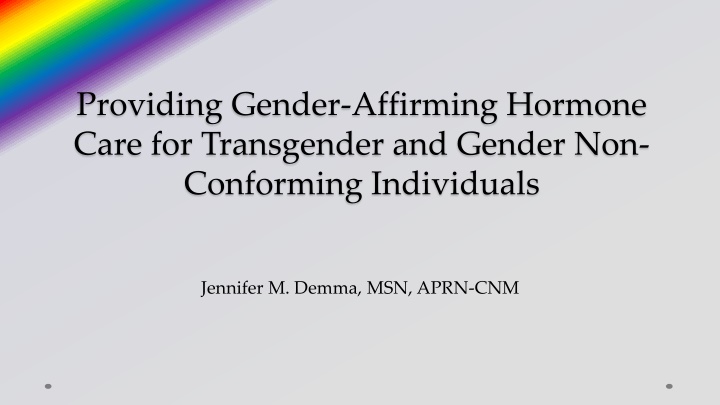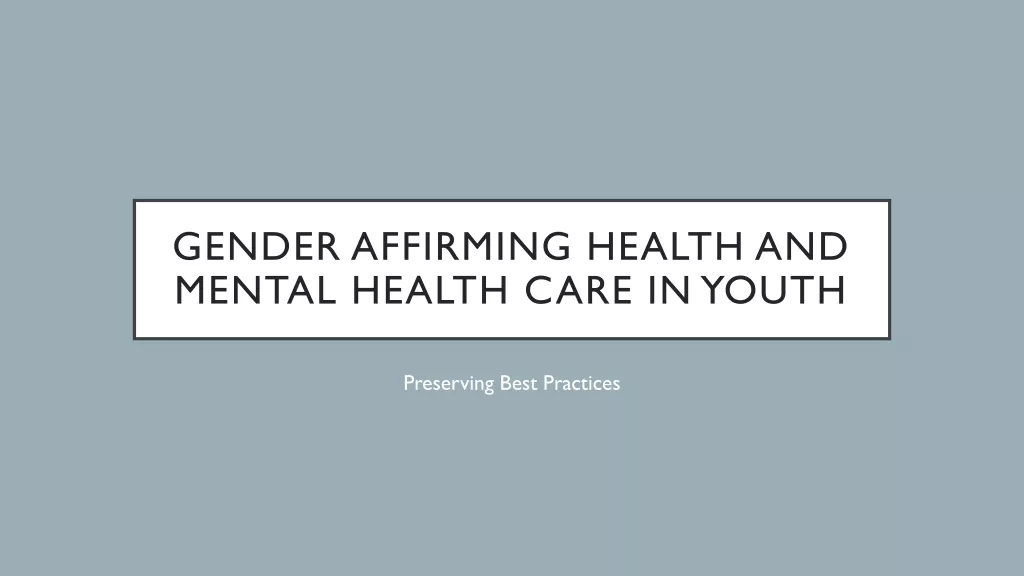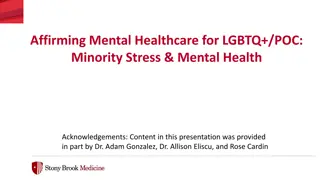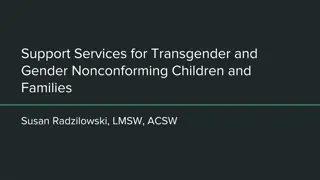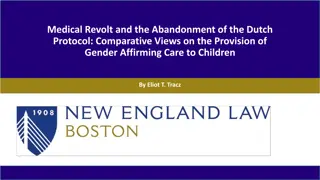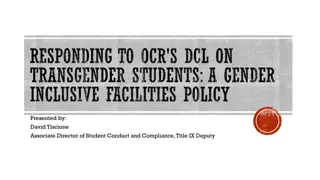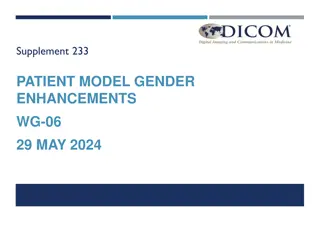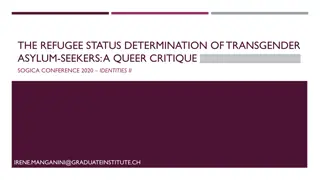Gender-Affirming Hormone Care for Transgender Individuals
Jennifer M. Demma, APRN-CNM, explores the importance and benefits of providing gender-affirming hormone care for transgender and gender non-conforming individuals. The presentation covers informed consent, clinical practices, and hormone therapy protocols. Gender dysphoria and the benefits of gender-affirming care are discussed, emphasizing mental health and quality of life improvements. Gender-affirming care is highlighted as individualized, ongoing, and multidimensional, encompassing social, psychological, medical, and legal aspects.
Download Presentation

Please find below an Image/Link to download the presentation.
The content on the website is provided AS IS for your information and personal use only. It may not be sold, licensed, or shared on other websites without obtaining consent from the author.If you encounter any issues during the download, it is possible that the publisher has removed the file from their server.
You are allowed to download the files provided on this website for personal or commercial use, subject to the condition that they are used lawfully. All files are the property of their respective owners.
The content on the website is provided AS IS for your information and personal use only. It may not be sold, licensed, or shared on other websites without obtaining consent from the author.
E N D
Presentation Transcript
Providing Gender-Affirming Hormone Care for Transgender and Gender Non- Conforming Individuals Jennifer M. Demma, MSN, APRN-CNM
Disclosures o No disclosures or conflicts of interest
Objectives 1. Understand informed consent and harm reduction principles as applied to provision of gender-affirming hormone care. 2. Identify best clinical practices for providing gender-affirming hormone care to transgender and gender non-conforming individuals. 3. Understand and be prepared to offer basic hormone therapy protocols for gender affirmation, including knowledge of common side effects and monitoring of medical transition
Jennifer M. Demma, MSN, APRN-CNM o Pronouns: She/Her/Hers o CNM since 2000 o Clinical Practice Director o Family Tree Clinic, St Paul, MN o jdemma@familytreeclinic.org
Gender Dysphoria Feeling of distress due to one s internal sense or perception of their own gender not being congruent with the sex they were assigned at birth, or their natal sex. o Result of interactions of biological, environmental, psychosocial, and cultural factors. Not all transgender people experience gender dysphoria but those who do often feel isolated. o Contributes to increases in anxiety and depression. Diagnosis classified in the DSM-5 o Increasing evidence that gender dysphoria is best treated by a multi-disciplinary approach which includes gender-affirming hormone therapy. (Hembree et al., 2009; Atkinson & Russell, 2015; Schmidt & Levine, 2015)
Benefits of Gender Affirming Care Gender affirmation is essential to health and wellbeing for transgender and gender nonconforming people and communities. o Decreased mental health risks o Decreased suicide o Improved quality of life (Bauer et al., 2015; Reisner, Radix, & Deutsch, 2016)
Gender Affirming Care Individualized and can change with time and is ongoing o No one way to affirm gender o Not necessarily a linear process o Gender expression is not the same as gender identity and may or may not change as a part of gender affirmation May involve hormone therapy or not May involve surgery or not May involve name change and/or gender marker change or not Social; psychological; medical; and legal
Why Should We Provide Hormones? Improvements in gender dysphoria, psychological functioning, comorbidities, sexual functioning and overall quality of life. More providers = improved access to health care. o Decreases in health disparities Build trust and strengthen the clinician-patient relationship. Within our scope of practice, not an endocrine specialty o Majority of endocrinologists also report little to no experience with transgender patients. o Only ~16% report currently caring for > 5 transgender patients. o Over 2/3 received no training in medical school or fellowship. (Irwig, 2016; Murad et al., 2010)
Goals of Gender- Affirming Hormone Therapy Broad overall goal: o Help people live authentically in congruence with how they view themselves internally and their values. Medically: o Suppress the secondary sex characteristics of the gender the person was assigned at birth by blocking endogenous sex hormones. o Induce the development of secondary sex characteristics of the gender with which the person identifies by administering hormones consistent with that sex. (Hembree et al., 2009)
Hormone Therapy Guidelines Lack of consensus and limited longitudinal studies. Review the published guidelines: o UCSF, Center of Excellence for Transgender Care Guidelines for the Primary and Gender- Affirming Care of Transgender and Gender Non-Binary People o Fenway Health The Medical Care of Transgender Persons o Callen-Lorde Protocols for the Provision of Hormone Therapy o Endocrine Treatment of Gender-Dysphoric/Gender-Incongruent Persons: An Endocrine Society Clinical Practice Guideline, 2017 o WPATH Standards of Care, Version 7 o It is ok to simply pick one and follow an established set of guidelines it is more harmful to withhold hormone therapy for gender affirmation. WPATH has listserv for questions join WPATH and follow listserv. Talk with other providers.
Informed Consent Communicating benefits, risks, side effects, alternatives, limitations of knowledge, and risk of no treatment. Respecting patient autonomy and right of self-determination. Person as the expert in their well-being. Partnership with provider-patient Removing gatekeeping Does not mean lack of clinical assessment & does not mean that hormones are always prescribed. o Clinician assesses readiness to initiate hormone therapy and documents that patient has capacity to make informed consent. Minimal risk of regret and NO malpractice suits found in study of clinics using informed consent model. (Center of Excellence for Transgender Health, 2016; Cavanaugh, Hopwood, & Lambert, 2016; Deutsch, 2012; WPATH, 2012)
Initial Assessment and Readiness Subjective o Describe to me how you came to identify as transgender/gender non- conforming/agender/non-binary . o What are your goals for hormone therapy? o What are the changes you are most hoping to see when you start hormones? o What are some of the barriers you anticipate with transition? o Who in your life is supportive of you? Who are you out to? o Are you in a safe place to transition? o Are you sexually active? o Do you see yourself as a parent in the future?
Initial Assessment and Readiness Review current medications, PMHx, and FHx Review of Informed Consent Counseling o Expectations of hormone therapy Timelines of physical changes o Minimizing modifiable risk factors Smoking cessation, alcohol and drug use, safer sex practices o Set timeline for follow up appointments at 3, 6, 9, and 12 months in the first year then every 6-12 months and PRN.
Exams and Screenings Physical exam o Vital signs o Heart, lungs, thyroid, abdomen, offer breast/chest exam if indicated Genital exam o Not required o Recommend per screening guidelines Screenings recommend based on sexual behaviors and guidelines o STI s o Pap o Prostate Vaccinations o HPV o Flu Contraception if indicated
Initial Labs o Feminizing: Fasting lipid panel CMP Diabetes screen if indicated/risk factors Consider baseline prolactin o Masculinizing: Fasting lipid panel CBC LFTs Diabetes screen if indicated/risk factors UPT if at risk of pregnancy Baseline testosterone if PCOS (Cavanaugh, Hopwood, Gonzalez, & Thompson, 2015)
Follow-up Labs Feminizing -- Example of recommendation from Fenway o Potassium and BUN/Cre at 2-8 weeks after starting or changing dose o Lipids, diabetes screen, electrolytes, BUN/Cre at 6 mos then every 6-12 mos o Prolactin yearly o Testosterone at 6 months after stable dose or inadequate feminizing -- goal is in pre- menopausal cis-female lab range o Estradiol -- if on injectables; target middle of premenopausal cis-female lab range NOTE: UCSF, Endocrine Society, Callen Lorde, etc. all vary in guidelines and recommendations lack of consensus. (Cavanaugh, Hopwood, Gonzalez, & Thompson, 2015)
Table 2. Laboratory monitoring for feminizing hormone therapy Test Comments Baseline 3 months* 6 months* 12 months* Yearly PRN * In first year of therapy only ** Used to calculate bioavailable testosterone; monitoring bioavailable testosterone is optional and may be helpful in complex cases (see text) Only if spiro used BUN/Cr/K+ X X X X X X No evidence to support monitoring at any time; use clinician discretion Based on USPSTF guidelines Lipids X No evidence to support monitoring at any time; use clinician discretion Based on USPSTF guidelines A1c or glucose Estradiol X X X Total Testosterone X X X X Sex Hormone Binding Globulin (SHBG)** X X X X Albumin** X X X X Only if symptoms of prolactinoma Prolactin X Source: UCSF Center for Excellence in Transgender Health, 2016
Follow-up Labs Masculinizing Example of recommendation from Fenway o CBC, lipids, LFTs at 6 months and every 6-12 months o Other labs based on risks i.e., diabetes screening o Serum total testosterone if inadequate masculinizing response (i.e., no cessation of menses at 6 months) or if checking for supraphysiologic levels; try to get mid-injection interval; targeting mid range of cis-male lab levels NOTE: UCSF, Endocrine Society, Callen Lorde, etc. all vary in guidelines and recommendations lack of consensus. (Cavanaugh, Hopwood, Gonzalez, & Thompson, 2015)
Table 2. Titration and monitoring of masculinizing hormone therapy Therapy Comments * In first year of therapy only; ** is optional and may be helpful in complex cases (see text) Used to calculate bioavailable testosterone; monitoring bioavailable testosterone Baseline 3 months* 6 months* 12 months* Yearly PRN No evidence to support lipid monitoring at any time; use clinician discretion Based on USPSTF guidelines Lipids X No evidence to support lipid monitoring at any time; use clinician discretion Based on USPSTF guidelines A1c or fasting glucose X Estradiol X Total Testosterone X X X X Sex Hormone Binding Globulin (SHBG)** X X X X Albumin** X X X X Hemoglobin & Hematocrit X X X X X X Source: UCSF Center for Excellence in Transgender Health, 2016
Hormone Medications Feminizing o Anti-androgen Spironolactone Finasteride Others o Estrogen Transdermal patch Injections IM Tablets Masculinizing o Testosterone Transdermal o Gel o Pump o Creams o Patch Injections o IM or SQ o Every 10 week injection Implants
Risks of Feminizing Hormones Likely increased risk: o VTE (higher risk with oral estradiol than transdermal estradiol; difficult to determine given use of ethinyl estradiol and conjugated estrogens in the past which are not recommended) risk increased with risk factors: >40, smoking highly sedentary Underlying thrombophilic disorders o Gallstones o Elevated liver enzymes o Hypertriglyceridemia o Cardiovascular disease (other risk factors contribute and age >50) (WPATH, 2012)
Risks of Feminizing Hormones Possible increased risk o Hypertension o Hyperprolactinemia or prolactinoma o Type 2 diabetes Inconclusive or no increased risk o Breast cancer o Pre-existing lipid d/o may benefit from transdermal versus oral estradiol (WPATH, 2012)
Risks of Masculinizing Hormones Likely increased risk: o Polycythemia o Acne o Androgenic alopecia o Sleep apnea (WPATH, 2012)
Risks of Masculinizing Hormones Possible increased risk: o Elevated liver enzymes o Hyperlipidemia (transdermal may be more lipid neutral) o Destabilization of psychiatric disorders associated with higher doses or supraphysiologic blood levels, bipolar, schizoaffective or other disorders that may include manic or psychotic symptoms (WPATH, 2012)
Risks of Masculinizing Hormones Inconclusive or no increased risk o Cardiovascular disease (mostly with risk factors) o Hypertension (not from hormone therapy alone; risk factors) o Type 2 diabetes o Loss of bone density o Breast/cervical/ovarian/uterine CA (WPATH, 2012)
Absolute Contraindications Estrogen o Previous VTE related to underlying hypercoagulable condition; history of estrogen sensitive neoplasm; end stage chronic liver disease o Other conditions, i.e., HTN are not necessarily absolute contraindications goal is reasonably well controlled prior to starting hormone therapy; may need consultations before starting meds but may be able to start spironolactone initially then add in estradiol once BP well controlled Testosterone o Pregnancy; unstable coronary artery disease; untreated polycythemia with a Hct 55% or higher; consult with oncologist with history of breast or other estrogen dependent CAs (due to aromatization of testosterone) (WPATH, 2012)
Effects & Onset of Feminizing Hormones Effect Expected Onset Time to Max Effect Body fat redistribution 3-6 months 2-5 years Decreased muscle mass 3-6 months 1-2 years Skin softening 3-6 months Decreased libido 1-3 months 1-2 years Decreased spontaneous erections 1-3 months 3-6 months *Breast growth 3-6 months 2-3 years Testicular atrophy 3-6 months 2-3 years *Decreased sperm production Variable Variable Thinning body and facial hair 6-12 months > 3 years * Permanent effects (WPATH, 2012)
Feminizing Hormone Therapy All considered off label. Multi-medication therapy: o Androgen blocking o Estradiol o Progestagen??? Primary class of estrogen used = 17-beta estradiol. o Bioidentical hormone o Delivered oral, injectable, transdermal patch Ethinyl estradiol and conjugated equine estrogens NOT recommended due to increased VTE risk and inability to accurately measure serum levels. (Center of Excellence for Transgender Health, 2016)
Feminizing Hormone Therapy Androgen blocking o Spironolactone first line Initial 50mg PO BID OR 100mg PO QD Can increase to 150mg or 200mg daily to achieve testosterone suppression Max dose 400mg QD (200mg PO BID) (UCSF) o Finasteride second line or unable to use spironolactone or to promote hair regrowth 5mg PO daily Titrate dosing based on suppression of testosterone goal in premenopausal cis-female range If binary goals (Center of Excellence for Transgender Health, 2016)
Feminizing Hormone Therapy Estradiol o Oral/sublingual: 2-8mg in divided doses daily Initial 2-4mg / day (2mg QD or BID) Increase to 6-8mg / day If up to 8mg / day should consider changing to IM; risk of VTE higher with 8mg PO than with injectable. o Intramuscular injection: Estradiol Valerate 20-40mg q 2 weeks OR Estradiol Cypionate 2-5mg IM q 2 weeks (UCSF) Clinically can often see supratherapeutic levels and may need lower doses; i.e., Endocrine Society Guidelines recommend 2mg IM weekly or 5mg IM q 2 weeks starting dose o Transdermal - Estradiol patch 0.1mg/24 hours 1 patch change every 3-4 days 2 patches total per week (max 3-4 patches at a time/6-8 patches per week) Titrate dosing based on desired effects and interpretation of hormone levels on lab results. o Not yet evidence based. o If measuring estrogen want it to be in the range of a pre-menopausal cisgender female. (Center of Excellence for Transgender Health, 2016)
Feminizing Hormone Therapy Progestagens Micronized Progesterone 100mg-200mg QHS or Medroxyprogesterone acetate 5mg- 10mg QD o Controversial and no agreement on usefulness vs. safety o No well designed studies for the role of progestagens in treatment of trans women. Anecdotal evidence shows addition of progestagen can improve breast and areolar development, mood, and libido. o Concerns from WHI increased risk of CVD and BrCA HOWEVER trans women are typically younger, have lower risk of BrCA, different estrogen used in WHI Goals for trans women are improvements in mental health and quality of life, not disease prevention. Risks in trans women a likely minimal or absent. (Center of Excellence for Transgender Health, 2016)
Maintenance Feminizing Hormones At follow up visits: o Review changes in Med hx; Social hx; Psychosocial Needs o Assess for medication response: Skin changes; Body shape changes Breast growth Facial and body hair growth Changes in frequency of erections, libido, testicle size Mood o Assess for adverse side effects headaches, nipple discharge, vision changes, pain/swelling in legs, chest or abdominal pain o Verify dosing and schedule of medication. o Physical exam as indicated o Does not occur in a vacuum Remember: Sexual partners, need for STI screening? Prostate screenings if age appropriate.
Effects & Onset of Masculinizing Hormones Effect Expected Onset Time to Max Effect Skin oiliness/acne 1-6 months 1-2 years *Facial/body hair growth 3-6 months 3-5 years Increased muscle mass 3-6 months 2-5 years Body fat redistribution 3-6 months 2-5 years Cessation of menses 2-6 months *Clitoral enlargement 3-6 months 1-2 years Vaginal atrophy 3-6 months 1-2 years *Voice deepening 3-12 months 1-2 years *Male pattern baldness >12 months Variable * Permanent effects (WPATH, 2012)
Masculinizing Hormone Therapy All considered off label. All testosterone preparations in the U.S. are considered bioidentical. Testosterone cypionate or enanthate o Initial dose 20-50mg q week SQ or IM o Increase to max 100mg q week SQ or IM (can increase in intervals, i.e., change from 40mg/week to 50mg/week or 60mg/week x 3 months and re-evaluate) Testosterone topical gel 1% o Initial dose 12.5-50mg q am o Increase to max 100mg q am o Slower onset of results and lower peaks than SQ/IM Titrate dosing based on desired side effects and interpretation of hormone levels on lab results. o Not yet evidence based. o Use reference ranges for cisgender men. Goal is for mid-range at mid-injection cycle (lab dependent). (Center of Excellence for Transgender Health, 2016)
Maintenance Masculinizing Hormones At follow up visits: o Review changes in Med hx, Social hx; Psychosocial Needs o Assess response to medication: Facial and body hair growth Deepening of voice Cessation of menses Skin changes, acne, body odor Clitoral growth/ bottom growth Mood Body shape changes o Verify dosing and schedule of medication. o Physical exam as indicated Does not occur in a vacuum Remember: o Sexual partners, need for STI screening or contraception? o Continue to discuss recommendations for cervical cancer screening
Example Visit Schedule Initial Visit: full histories, assess need for additional care or conditions needing care before hormone start or any absolute contraindications or medical interactions, informed consent & hormone education, baseline labs Follow-up visit in 1-2 weeks: physical exam (chest/breast and genital exams not required), lab review, hormone start if no absolute contraindications Follow-up visits Q 3 months until stable dose then every 6-12 months
References Atkinson, S.R., & Russell, D. (2015). Gender dysphoria. Australian Family Physician, 44(11), 792-796. Retrieved from http://www.racgp.org.au/afp/2015/november/gender-dysphoria/ Bauer, G.R., Scheim, A.I., Pyne, J., Travers, R., & Hammond, R. (2015). Intervenable factors associated with suicide risk in transgender persons: A respondent driven sampling study in Ontario, Canada. BMC Public Health, 15. doi: 10.1186/s12889-015-1867-2 Boudreau, D. & Mukerjee, R. (2019). Contraception care for transmasculine individuals on testosterone therapy. Journal of Midwifery & Women s Health, 64(4). Callen-Lorde Community Health Center. (2014). Protocols for the provision of hormone therapy. callen-lorde.org/transhealth/ Cavanaugh, T., Hopwood, R. Gonzalez, A, & Thompson, J. (2015). The medical care of transgender persons. Boston, MA: Fenway Health. Cavanaugh, T. Hopwood, R., & Lambert, C. (2016) Informed consent in the medical care of transgender and gender-nonconforming patients. AMA Journal of Ethics, 18(11): 1147-1155. Center of Excellence for Transgender Health, Department of Family and Community Medicine, University of California San Francisco. (2016). Guidelines for the primary and gender- affirming care of transgender and gender nonbinary people (2nd ed). www.transhealth.ucsf.edu/ guidelines. Deutsch, MB. (2012). Use of the informed consent model in the provision of cross-sex hormone therapy: A survey of the practices of selected clinics. International Journal of Transgenderism, 3: 140-146.
References Ellis, A., Wojnar, D. M., & Pettinato, M. (2014). Conception, pregnancy, and birth experiences of male and gender variant gestational parents: It s how we could have a family. Journal of Midwifery & Women s Health, 60 (1). Ellis, S. & Dalke, L. (2019). Midwifery care of transfeminine individuals. Journal of Midwifery & Women s Health. 64: 298-311. Hembree, W.C., Cohen-Kettenis, P., Gooren, L., Hannema, S.E., Meyer, W.J., Hassan Murad M., Rosenthal, S.M., Safer, J.D., Tangpricha, V., & T Sjoen, G.G. (2017). Endocrine treatment of gender-dysphoric/gender-incongruent persons: An Endocrine Society clinical practice guideline. The Journal of Clinical Endocrinology and Metabolism, 102(11), 3869-3903. Irwig, M. (2016). Transgender care by endocrinologists in the United States. Endocrine Practice, 22(7), 832-836 James, S. E., Herman, J. L., Rankin, S., Keisling, M., Mottet, L., & Anafi, M. (2016). Executive summary of the report of the 2015 U.S. Transgender Survey. Washington, DC: National Center for Transgender Equality Murad, M.H., Elamin, M.B., Garcia, M.Z., Mullan, R.J., Murad, A., Erwin, P.J., Montori, V.M. (2010). Hormonal therapy and sex reassignment: a systematic review and meta-analysis of quality of life and psychosocial outcomes. Clinical Endocrinology, 72, 214- 231. Reisner, S.L., Radix, A., & Deutsch, M.B. (2016). Integrated and gender-affirming transgender clinical care and research. Journal of Acquired Immune Deficiency Syndrome. 72(suppl 3):S235-S242. doi: 10-1097/QAI.0000000000001088 Schmidt, L., & Levine, R. (2015). Psychological outcomes and reproductive issues among gender dysphoric individual. Endocrinology Metabolism Clinics of North America, 44, 773-785 World Professional Association for Transgender Health (WPATH). (2012). Standards of care for the health of transsexual, transgender, and gender-nonconforming people, version 7. Wylie, C. H., Cohen-Kettenis, P. T., Gooren, L., Hannema, S. E., Meyer, W. J., Murad, M. H., Rosenthal, S. M., Safer, J. D., Tangpricha, V., & T Sjoen, G. G. (2017). Endocrine treatment of gender-dysphoric/gender-incongruent persons: An endocrine society clinical practice guideline. The Journal of Clinical Endocrinology & Metabolism, 102(11): 3869-3903.
